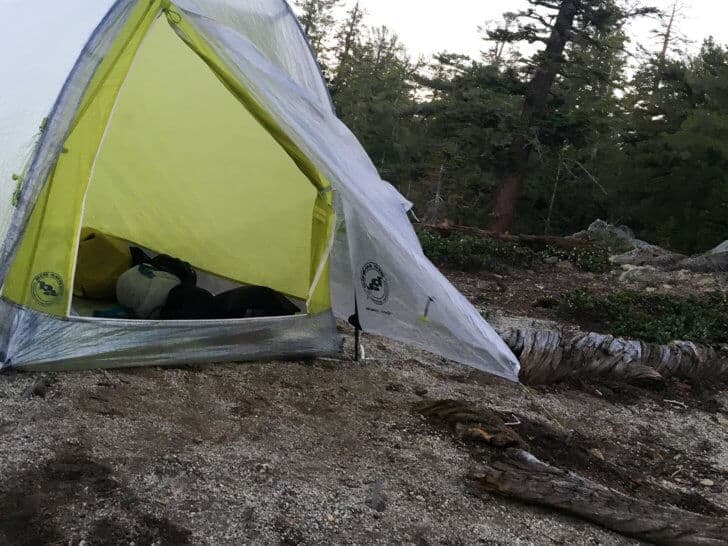Introduction
The Big Agnes Fly Creek HV 1 Carbon is a one-person, double-wall, three-season, semi-freestanding shelter. Weighing in at 21 oz (595 g), the Fly Creek HV 1 Carbon is lightweight, given that it is a double-wall shelter. Plus, the weight includes the hub-and-pole assembly, stakes, guylines, fly and stuff sack!
The Big Agnes Fly Creek HV 1 Carbon minimizes its weight compared to similar shelters primarily through judicious use of fabric and premium material sourcing. The bathtub floor and the precisely cut fly are both manufactured from thin Dyneema Composite Fabric, while the canopy is made from lightweight ripstop nylon. The poles are constructed of 8.7 Easton carbon fiber. The interior space and vestibule area are minimal, bordering on cramped, something the shelter shares with its silnylon cousin, the Fly Creek HV 1 Platinum.
In short – this is cottage industry material applied to a well-known (if not universally loved) design. The question is, is it worth the $800.00 price tag?

Features and Specifications
Features
- Single entry (front)
- Side entry vestibule
- Welded construction
- Solid interior canopy (as opposed to mesh)
- Storm flaps on vestibule zipper
- Hook and loop tabs to connect fly to pole structure
- Comes with pre-cut guylines and attached line tensioners
- Color-coded buckles and webbing for easy set-up
- Dome structure
- Single pole-and-hub architecture
- Reflective guylines and webbing
- Interior loops for optional gear storage (or Big Agnes storage accessories)
- Comes with self-adhesive repair patches
- Interior mesh pockets
- Large zipper pull for easy grip
- Oversize loop and tab closures (for gathering and holding up fly and canopy doors)
Specifications
- Total Fly + Inner Weight (including stakes and poles): 21 oz (595 g) (claimed, and verified)
- Fly Weight (including stakes and poles): 13 oz (369 g)
- Materials*:
- Inner tent canopy: ripstop nylon
- Fly: Dyneema Composite Fabrics (CTF-style)
- Poles: 8.7 mm (.3 in) Easton carbon fiber
- Pole hub: aluminum
- Packed Size: 5 in x 18 in (13 cm by 46 cm)
- Floor Area: 19 sq ft (1.8 sq m)
- Vestibule Area: 5 sq ft (.46 m)
- Apex Height: 39 in (99 cm)
- Stakes Needed (max): 11
- Stakes Included: 11
*NOTE: Big Agnes would not provide the specific denier of the fly, floor, or canopy fabric.
Review Context

This test represents my first experience with the Big Agnes Fly Creek line of shelters.
For this review, I wanted to look at the Big Agnes Fly Creek HV 1 Carbon within the context of the traditional strengths and weaknesses of double-walled shelters.
- How did it perform under cold, wet, and condensation heavy conditions?
- How did it hold up in the wind?
- How did its weight and packability compare to other one-person double-walled shelters?
Due to an $800 price tag, a major priority for me testing this shelter was durability. It’s hard to imagine tossing down that kind of cash for a shelter that doesn’t hold up. I was on the lookout for any material or design flaws that would have rendered the tent unusable over time.
Finally, I examined the Fly Creek HV 1 Carbon’s usability and livability:
- How easy was it to set up (in calm conditions, wind, or rain)?
- What kind of features does it possess, and what contributions do those features make?
- If I had to spend a day in the tent waiting out a particularly nasty storm, how comfortable (or not) would that day be?
That $800 cost means the Fly Creek HV 1 Carbon is competing with some of the lightest, most well-designed single person shelters on the market. It would have to be a truly exceptional shelter to stand out.
I tested the Fly Creek HV 1 Carbon on two very different excursions. The first was a six-and-a-half day summer thru-hike of the Tahoe Rim Trail. On this hike, I was moving fast and making use of every scrap of available daylight. I rarely pitched the shelter until after eight in the evening, and I was packing up each morning shortly after five in the morning. The weather was fair and dry, dropping down into the forties (deg F) and high thirties (deg F) overnight.
On this hike, the Fly Creek HV 1 Carbon’s weight, ease of use, and packability were my prime concerns.
My second test was a five-night, off-trail, group hike in the Absaroka-Beartooth Wilderness. The testing conditions on this trip were cold, wet, and windy. Overnight temperatures were often in the thirties, occasionally dropping below freezing. These were ideal conditions to examine the Fly Creek HV 1 Carbon’s stability, and its performance in precipitation, condensation management, and durability.
Fall daylight hours and more time in camp made for a good chance to get a feel for the Fly Creek HV 1 Carbon’s livability and afforded me the time to examine each feature in detail.
Performance Assessment
My Performance Assessment of the Big Agnes Fly Creek HV 1 Carbon covered the following items:
- Wind and Weather Resistance
- Ease of Use
- Condensation Management
- Durability
- Livability
- Compressibility and Weight
Member Exclusive
A Premium or Unlimited Membership* is required to view the rest of this article.
* A Basic Membership is required to view Member Q&A events




Home › Forums › Big Agnes Fly Creek HV 1 Carbon Review (Tent)